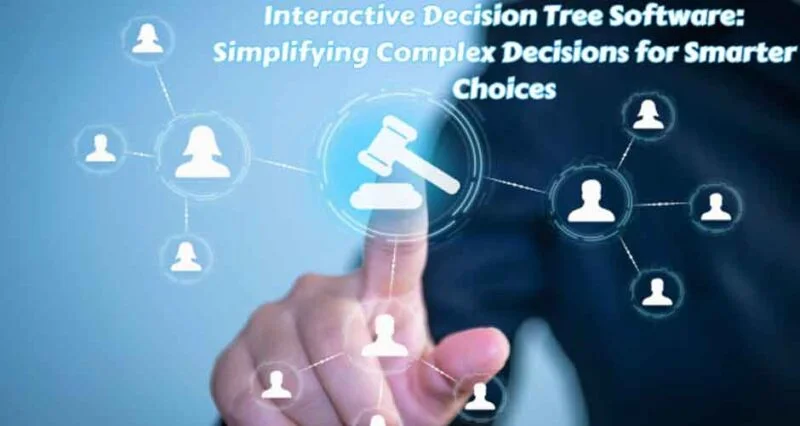
Making complex decisions can be challenging, with many interconnected variables to consider. Interactive decision tree software simplifies and optimizes these choices by visually mapping out options in an intuitive, guided manner. With key features like decision modeling, flow visualization, and guided pathways, these tools aim to enhance processes and empower smarter decision-making.
Streamlining Complex Decision Frameworks
Complex decisions often have multiple options and many interdependent variables. Trying to juggle all these in our heads can be cognitively taxing. Interactive decision tree software provides a visual overview of the decision architecture, helping to organize and simplify choices.
Modeling the decision as a flow chart or tree diagram allows users to visually map out options, weighing the pros and cons at each branch. This logical structuring of decisions into clear pathways helps streamline the process into understandable steps.
Additionally, features like conditional logic allow users to define dynamic decision rules. This simplifies the framework by automatically adjusting downstream choices based on earlier selections.
Enhancing the Decision Process through Visualization
Interactive decision tree tools enhance the decision process through intuitive visualization features. These include:
Visual Mapping of Decision Flows:
The software visually maps out the decision flow using branches and tree diagrams. This creates an interactive overview of the decision architecture. The flow chart structure shows each step in the decision process from start to finish.
Users can see all options laid out simultaneously. The tree branches show how choices lead to different outcomes. This visual mapping simplifies complex decisions into an easy-to-grasp format. Having the full decision flow visualized enables better understanding.
Guided Decision Pathways
The decision tree flow chart interactively guides users through each choice node. As options are selected, the tree branches lead to the next decision points. This step-by-step guidance simplifies complex decisions into clear and understandable steps.
The visualization shows users exactly where they are in the decision process. Icons indicate the recommended path based on users’ selected goals. The intuitive flow charts make it simple to navigate the decision.
Modeling Implications of Choices
The decision tree models display how each branch decision impacts outcomes. Dynamic decision rules update probabilities and outcome possibilities at each step.
Visual data tools clearly show these changing outcome implications as users navigate branch choices. This modeling gives clarity on how current choices influence final results. Users can make informed decisions at each step.
Testing Scenarios with Sensitivity Analysis
Decision variables can be adjusted to view effects on outcomes instantly. This on-the-fly scenario testing is called sensitivity analysis.
Users can visualize how tweaking variables like budgets, resource allocation, or timelines affects the optimal path. The dynamic visual updates help find the best decision scenario.
Summary Visual Reporting
Visual data summarizes key decision factors in charts and graphs. These include:
- Probability scores of potential outcomes
- Comparison reports of scenario tests
- Sensitivity analysis of decision variables
The reporting visualizations provide at-a-glance data to optimize the decision.
Smarter Decision-Making through Guidance
The guided nature of interactive decision trees enables better informed and optimized choices. Key features that drive smarter decision-making include:
Intuitive Interfaces Reduce Mental Workload
The visual interfaces are designed to be simple and user-friendly. Icons, diagrams, and interactive charts provide an intuitive way to display complex information and choices.
This intuitive format reduces the mental workload required to use the software. Less cognitive effort is needed to process the decision when it is visually guided in clear steps.
Contextual Guidance at Decision Points
At each choice point in the decision tree, relevant information is displayed to guide the user. The software gives context about that specific decision node.
Factors like the pros/cons, trade offs, alignments with goals, and probable outcomes are presented. This contextual guidance based on the current decision enables better-informed choices.
Software Suggests Optimal Pathways
Based on the predefined goals and decision variables input by the user, the software can suggest high-value pathways. AI algorithms help identify the best path forward at each step.
By optimizing suggestions, the software guides users towards choices most likely to achieve the desired goals. This promotes better decisions.
Scenario Testing for Smarter Choices
Users can rapidly simulate different choice combinations and scenarios. The interactive decision tree updates in real time, allowing users to compare scenario outcomes.
This ability to visualize different scenarios and their impacts enables smarter decision-making. Users can instantly see how choices affect optimal pathways and objectives.
Evaluating Risks and Rewards
Visual data like probability scores and risk matrices help assess decision risks and tradeoffs. Reward potential is also displayed.
This visibility into risks versus rewards enables fully informed choices. Users can balance risk appetite with reward goals at each step.
Audit Trails for Retrospective Analysis
Full audit trails track the decision logic, variables, and branches taken. Users can revisit previous decision points in the tree to understand the “why” behind choices.
This supports retrospective analysis to continue optimizing the decision model. Audit trails also enable analysis of past decisions to improve future choices.
Uses of Interactive Decision Software
Interactive decision tree software provides versatile utility across many use cases, including:
- Business planning: Evaluating new market entry, product development, and project screening.
- Operations: Supply chain mapping, system troubleshooting, quality assurance processes.
- Finance: Investment decision analysis, portfolio optimization, risk management.
- Healthcare: Clinical decision support, treatment planning, medical diagnostics.
- Manufacturing: Design process optimization, cost-benefit analysis of designs.
- Marketing:Customer segmentation, channel optimization, messaging strategy.
These tools’ intuitive visual interface and guided decision modeling aim to enhance complex decision processes across many industries.
Conclusion
Interactive decision tree software provides a valuable tool for simplifying and optimizing complex, multi-variable decisions. The intuitive visual mapping and guided pathways make it easier to structure complex choices into clear, understandable flows.
Features like choice modeling, scenario testing, and risk/reward analysis further enhance the decision process. Combining simplified decision architectures with data-driven guidance and insights, this versatile software empowers organizations and individuals to make fully informed, smart decisions, ultimately driving better outcomes.
Key Takeaways
- Interactive decision trees simplify complex decisions through visual mapping of options in flowchart structures.
- Intuitive visual interfaces and guided pathways reduce the mental workload for users.
- Relevant guidance is presented at each decision node based on goals and variables.
- Software capabilities like scenario testing and sensitivity analysis allow for data-driven decision optimization.
- Risk/reward analysis provides greater visibility into potential decision tradeoffs.
- Decision tree software is versatile for business, operations, finance, and more.
FAQs
How do interactive decision trees simplify choices?
By visually mapping out options in a logical, guided flow chart format with contextual guidance.
What are some key features of decision tree software?
Intuitive visual interfaces, guided pathways, choice modeling, scenario testing, risk/reward analysis.
What are some common business uses?
Business planning, operations optimization, investment analysis, risk management, marketing.
How can decision trees promote smarter choices?
Through data-driven guidance, scenario testing, risk/reward visibility, and optimization suggestions.
Are decision tree tools flexible for complex or custom choices?
Yes, they allow full customization of decision variables, logic rules, and flows.


